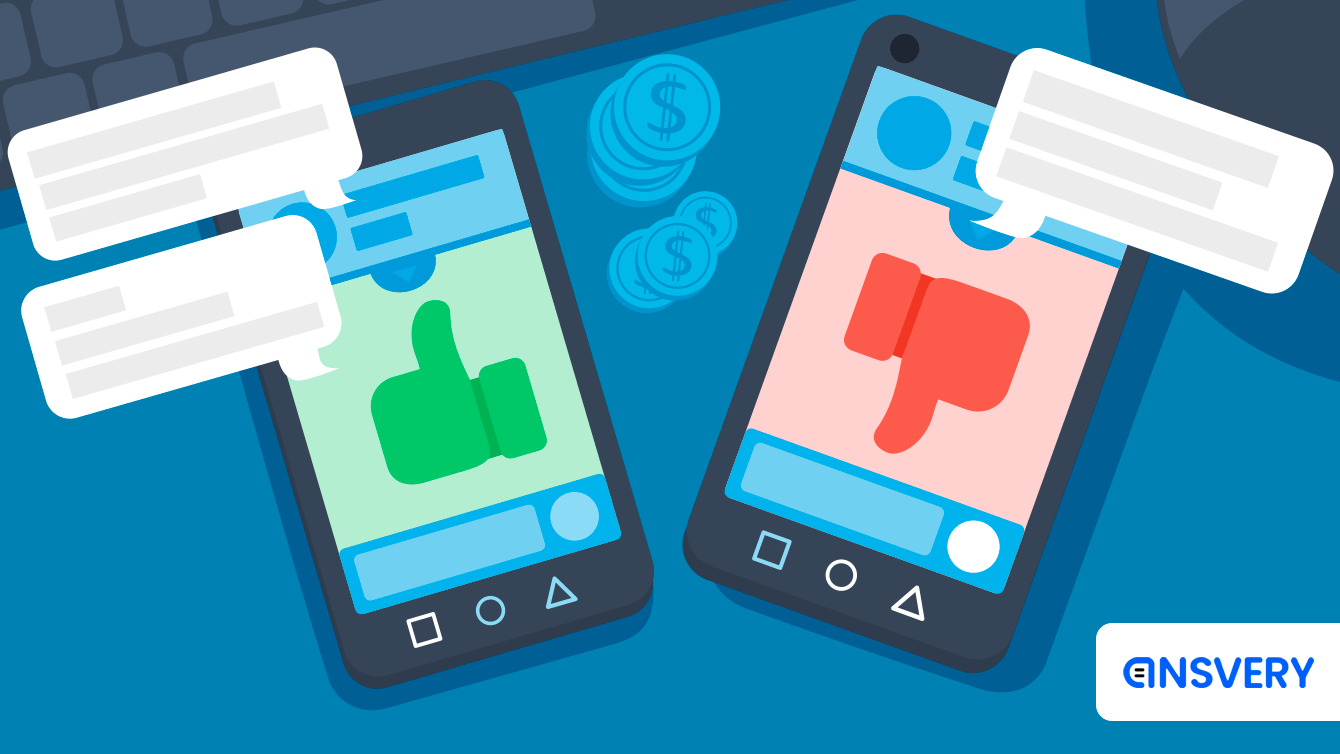Triple Impact: How Support Affects Profit, Loyalty, & Customer Experience
The author of the article, Maria Filippova, is a learning and development specialist in Ansvery. She follows the latest trends in customer communication and introduces the best practices into the workflow to assist her colleagues' personal growth and create a healthy culture of the support/customer interaction.
Maria is a linguist and a translator with a degree and 11 years of experience. She entered the world of Support four years ago. During this time, she has worked with two gaming support teams, studied their strategies, methods, and practices. She has compared and analysed the works of a number of Russian and foreign game development companies, assessed the existing support standards and customer expectations. In her spare time, Maria immerses herself into community management.
In this article, we will talk about the place support occupies in the general scheme of running a business, describe its functions and impact on profit, ponder on the relationships between support and developers, and share some interesting cases and trade secrets.
Much is said on the topic of customer support. So much, in fact, that it is becoming overwhelming. We hear at every corner that support is important but, somehow, when we turn the said corner, all arguments seem to melt and blur.
So why is this particular article going to be different? Can it be that I am going to say that customer support is unimportant? That, perhaps, mobile games is one of the fields where you can forget about niceties and ignore desperate pleas of the wronged?
That would be dramatically interesting but – sorry, no such luck. I can promise you though that I will not feed you commonplace and empty speeches of praise. Instead, you’ll get two most important kinds of facts, those of numbers and those of life, and also the thing we all love the most – a story.
Customer Experience as a Product
It all started when my mother decided to sell our old car. It was still running but it was so ancient that it predated and lacked a certain type of car registration, the vehicle identification number (VIN).
My mother is a keen smartphone user and she knew full well that the best chance to find a buyer for the poor wreck was to place an advert in a specialized app. She selected two popular apps that were pretty much equal competitors. With those two apps, she went through the same stages of user experience – she registered her account, received an offer to transfer to the premium version, found out that she could not submit an ad without the VIN, and contacted Customer Support with her problem.
From this point, her experience with the two apps began to differ. The first support agent did some thinking, came up with a solution, and even performed some extra services to assist. The second one sent my mother a canned reply and refused point-blank to do anything unless all the necessary info was present and correct.
You can only imagine the frustration caused by such a reply. And though mother did manage to place the ad in the second app as well, her conclusion was relentless: "This app doesn't do its job properly. They just want to scam me for my money". Now, this might sound a little strange - did the app not display the ad in the end? Did they not fulfill their function? But you see, they did not give her all that she wanted, and she did not receive the full service she counted on.
She did pay the first app the full price of their premium. They certainly were after her money as well but my mother needed to sell the car and she was prepared to pay those who she was sure would fully deliver.
The starting conditions of these two apps were exactly the same. Their customer journey was organized in the same way. Only one ingredient was different – proper Customer Support. And that alone became the deciding factor when it came to making a purchase.
Read more: Why Support is Important. Pros And Cons of Different Integration Options

So why am I telling you this story? I’m telling it to you because it is very indicative and a perfect illustration of a very important trend.
Today, if you wish to run a successful business, your key aim should be customer experience as a whole. In other words, customers prefer those companies that provide them with an excellent experience at every stage of their communication. It is said that customer support is part of the overall customer experience. It has been said for years. Сustomers are now so used to the idea that they have started to view support as part of the product itself. The deficiencies in your customer support will not be viewed as deficiencies in some additional services. They will be seen as deficiencies in your actual product. As a mobile game company, you provide several services at once – the product itself (the game), its maintenance (updates and fixes), and customer support. Users pay for the whole pack and they don’t like any part of it to be faulty.
I cannot promise you that this works the other way round. If your product is initially deficient and ultimately flawed, customer service will not save you. If you have not thought your game mechanics through, it will be very difficult for your support to cover for that. But if your product is solid, then bad support can dampen your reputation, and you cannot allow this to happen because you are constantly challenged by the competition. And what competition it is!
Fighting Off the Competition
The gaming market is booming. Mobile games are the most profitable games in the world. In fact, last year they generated 25% more profit than all other games combined. No surprise then that everyone wants their piece of the mobile profit pie. New games appear faster than mushrooms after the rain. The more money a genre brings, the more games of this type are designed. For example, companies are aware that casual games create a lot of revenue but users like to switch between several of them. So one company will create a number of casual games to maintain the users' interest in their company's efforts. On the other hand, companies also know that users spend most of their gaming time in core games. So the developers of those are always trying to outdo one another – to make game mechanics more flawless, the gameplay more gripping, the game process more stable. All this makes the competition intense. And as if it wasn’t bad enough to have all those game developers testing your abilities and skills, it's not just them you need to be wary of.
The market of non-gaming apps is also hot on your heels. Don’t get me wrong - the gaming market still holds the biggest part of the profit pie. However, during the last three years, non-gaming apps are stealing away the market percentage slowly but steadily. From 2016 to 2019 the proportion of the gaming market decreased from 82% to 72% and this loss is likely to grow even further. The subscription model in non-gaming apps is becoming increasingly popular and has fueled growth in spend. A user can now enjoy all the advantages of their favourite app for a reasonable sum that is discreetly deducted from their account every month. So imagine – the user has, let’s say, $100 a month to spend on mobile entertainment. They spend $50 on their favourite non-gaming app subscriptions, and for the rest of their money you need to battle with other games and other reasonable and tempting subscriptions. It can be a tough battle. In such circumstances, every positive thing, everything you do better, can play to your advantage. It is common knowledge that customer service, in general, is a rather weak spot with a large number of app development companies. So if you do it right, if you organize support properly, if you show your players respect, if you deal with their troubles and create genuine dialogue and connection, your customer service will become your competitive advantage.
Player Loyalty and an Antidote for Churn
There is a coffee shop in our city that also sells pies. Their coffee is very good but their pies could be better. And yet it is one of the most expensive and longest established coffee shops in the city and they never run out of customers. The secret is simple – they train their staff to deliver excellent service. They will engage in a pleasant conversation with you, they will recommend to you the best coffee and the best available pie, they’ll ask you random and amusing questions and they will own their screw-ups.
You might have heard these figures: 68% of customers say they will agree to pay more for excellent service. I, personally, have always been sceptical of these survey results – there is a sizable gap between what we say and what we actually do. I think it is fair to say that, in the gaming industry, quality of the product will always be the main factor in whether people pay you or not. And, frankly, I believe in people’s greed more than I believe in their desire for premium customer service. However, I become far less sceptical when 92% say they would ditch a company if they received poor customer service three times in a row. Bad experiences influence us more and act as a much better motivator, and three disappointments in a row can push away even the most forgiving of us. So good service does not, perhaps, attract users in itself but rather prevents them from leaving.
They will come to you because of the quality of your product, they will stay with you because of the quality of your product and your reasonable price policy, and they will tolerate all this longer because of the customer service you provide.
It is impossible to create a game that will be absolutely perfect, free of bugs and technical hiccups. Your customer service will be a lifesaver that will rescue relationships with your players and drag those relationships out of troubled waters. It is your safety net that prevents churn and boosts customer loyalty.
Loyal customers love you. They write kind reviews in stores and tell all their friends about you. Loyal customers cost you less. You’ll spend 7 times less money on keeping your existing user happy than on acquiring a new one. Loyal customers will potentially pay more. General payment habits of users prove it indirectly - they are ready to enter long-lasting relationships with businesses and they are prepared to pay them regularly by subscription. But no one will enter a long-lasting relationship with a partner who shows lack of proper attitude and care.
Insightful Conclusion
So here is a conclusion that I hope will not blur and melt. Your customer service is a valued part of your product pack, and as any part of your product, if found lacking, it can contribute to your profit loss. It can make you stand out among the sizable competition and help you get a bigger piece of the mobile market pie. It is responsible for keeping your customers loyal and it will prevent them from leaving you for all these new colourful games that are poured on them from every ad.
If you want them to stay and pay you and love you – love them back.




